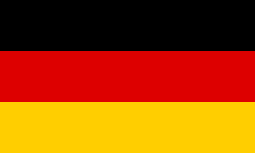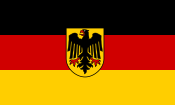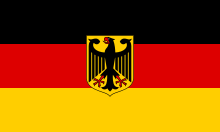
Back Vlag van Duitsland Afrikaans የጀርመን ሰንደቅ ዓላማ Amharic Bandera d'Alemanya AN علم ألمانيا Arabic علم المانيا ARZ Bandera d'Alemaña AST Almaniya bayrağı Azerbaijani آلمان بایراغی AZB Kobér Jerman BAN Flaggn vo Deitschland BAR
 | |
| Use | Civil and state flag, civil ensign |
|---|---|
| Proportion | 3:5 |
| Adopted | 3 July 1919 (original 2:3 ratio) 23 May 1949 |
| Design | A horizontal tricolour of black, red, and gold |
| Bundesdienstflagge und Dienstflagge der Landstreitkräfte der Bundeswehr | |
 | |
| Use | State flag and ensign, war flag |
| Proportion | 3:5 |
| Adopted | 7 June 1950 |
| Design | The civil flag with the coat of arms at the centre. |
| Dienstflagge der Seestreitkräfte der Bundeswehr | |
 | |
| Use | Naval ensign |
| Proportion | 3:5 |
| Adopted | 25 May 1956 |
| Design | A swallowtail of the civil flag with the coat of arms at the centre. |

 Common unofficial flag variant with the coat of arms of Germany
Common unofficial flag variant with the coat of arms of GermanyThe national flag of Germany (German: Flagge Deutschlands) is a tricolour consisting of three equal horizontal bands displaying the national colours of Germany: black, red, and gold (German: Schwarz-Rot-Gold).[1] The flag was first sighted in 1848 in the German Confederation. The flag was also used by the German Empire from 1848 to 1849. It was officially adopted as the national flag of the German Reich (during the period of the Weimar Republic) from 1919 to 1933, and has been in use since its reintroduction in the Federal Republic of Germany in 1949.
Since the mid-19th century, Germany has two competing traditions of national colours, black-red-gold and black-white-red. Black-red-gold were the colours of the 1848 Revolutions, the Weimar Republic of 1919–1933 and the Federal Republic (since 1949). They were also adopted by the German Democratic Republic (1949–1990).
The colours black-white-red appeared for the first time in 1867 in the constitution of the North German Confederation. This nation state for Prussia and other north and central German states was expanded to the south German states in 1870–71, under the name German Empire. It kept these colours until the revolution of 1918–19. Thereafter, black-white-red became a symbol of the political right. The Nazis (National Socialist German Worker's Party) re-established these colours along with the party's own swastika flag in 1933. After World War II, black-white-red was still used by some conservative groups or by groups of the far right, as it is not forbidden, unlike specific Nazi symbols such as the aforementioned swastika.
Black-red-gold is the official flag of the Federal Republic of Germany. As an official symbol of the constitutional order, it is protected against defamation. According to §90a of the German penal code, the consequences are a fine or imprisonment up to three years.
- ^ "Anordnung über die deutschen Flaggen" [Order concerning the German flags] (PDF) (in German). 13 November 1996. Archived (PDF) from the original on 5 September 2017. Retrieved 14 February 2012.
Die Bundesflagge besteht aus drei gleich breiten Querstreifen, oben schwarz, in der Mitte rot, unten goldfarben
[The federal flag consists of three horizontal stripes of equal breadth, black at the top, red in the middle, and gold-coloured at the bottom.]